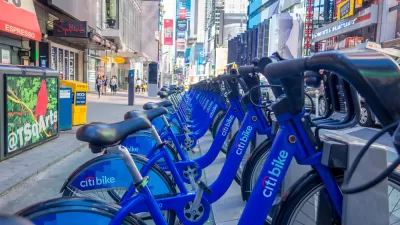Transit ridership is dropping, but a closer look at causes points to the role bike share could play in making transit a better option.

Alissa Walker reviews recent research about the causes of declining transit ridership in cities across the country. An analysis by researchers at the University of Kentucky shows that the introduction of bike share results in increases in rail ridership but decreases in bus ridership. In addition, ride-hailing operations in cities appear to lead to ridership decreases on both modes over time.
But shared mobility’s influence on transit ridership is not entirely clear cut. A new TransitCenter report says that ride-hailing services are drawing people away from transit, but riders are not completely abandoning transit. Instead, many are scaling back and replacing some transit trips with car trips.
These findings, along with Uber’s announcement that more people in Sacramento made trips on electric Jump bikes than in Uber vehicles in October 2018, indicate that bike share might play an important role in making transit a more viable option for travelers, particularly in places where shorter trips are the norm, says Walker.
"Providing better bus service should absolutely be an important priority for cities to improve transit ridership. But cities shouldn’t ignore the power of providing ubiquitous bikes and safer infrastructure to help capture transit-savvy riders as they’re making decisions about their next move," concludes Walker.
FULL STORY: How can cities boost transit ridership? Add more bike share

Maui's Vacation Rental Debate Turns Ugly
Verbal attacks, misinformation campaigns and fistfights plague a high-stakes debate to convert thousands of vacation rentals into long-term housing.

Planetizen Federal Action Tracker
A weekly monitor of how Trump’s orders and actions are impacting planners and planning in America.

In Urban Planning, AI Prompting Could be the New Design Thinking
Creativity has long been key to great urban design. What if we see AI as our new creative partner?

King County Supportive Housing Program Offers Hope for Unhoused Residents
The county is taking a ‘Housing First’ approach that prioritizes getting people into housing, then offering wraparound supportive services.

Researchers Use AI to Get Clearer Picture of US Housing
Analysts are using artificial intelligence to supercharge their research by allowing them to comb through data faster. Though these AI tools can be error prone, they save time and housing researchers are optimistic about the future.

Making Shared Micromobility More Inclusive
Cities and shared mobility system operators can do more to include people with disabilities in planning and operations, per a new report.
Urban Design for Planners 1: Software Tools
This six-course series explores essential urban design concepts using open source software and equips planners with the tools they need to participate fully in the urban design process.
Planning for Universal Design
Learn the tools for implementing Universal Design in planning regulations.
planning NEXT
Appalachian Highlands Housing Partners
Mpact (founded as Rail~Volution)
City of Camden Redevelopment Agency
City of Astoria
City of Portland
City of Laramie





























